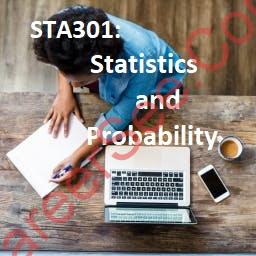Table of Contents
STA301 Statistics and Probability Handouts
STA301 Handouts pdf
Course Category: Probability & Statistics
Course Outline
Introduction to Statistics, Descriptive Statistics, Graphical representation of Data, Measure of central tendency, Measure of dispersion, Regression and Correlation, Counting techniques, Introduction to probability, Conditional probability, Baye’s theorem, Random variable (Discrete and continuous), Binomial, Hyper Geometric Poisson, Uniform and Normal distributions, Sampling distribution for mean and proportions, Estimation and Testing of hypotheses, Analysis of variance, Experimental design, Statistical use of elementary packages for explanatory Data analysis.
Statistics
Statistics is a field that affects the collection, editing, analysis, interpretation, and presentation of data. In applying mathematics to a scientific, industrial, or social problem, it is common, to begin with, the number of people or the mathematical model to be studied. People can be different groups of people or things like “all the people who live in the world” or “all the atoms that make up the crystal”. Statistics apply to the entire data section, including data collection planning according to the design of surveys and tests.
When census data cannot be collected, mathematicians collect data by creating specific experimental designs and test samples. Advocate samples confirm that assumptions and conclusions can be effectively transferred from the sample to the total population. Experimental research involves taking estimates of the underlying research system, exploiting the system, and then taking additional measurements using the same process to determine whether fraud has changed the values of the estimates. In contrast, observational research does not involve experimental fraud.
Descriptive statistics
Descriptive statistics are tables, graphs, and summaries of data numbers. The purpose of descriptive statistics is to facilitate the presentation and interpretation of data. Most of the statistical presentations from newspapers and magazines are natural. Different descriptive mathematical methods use data to improve understanding of single variations; Multivariate methods focus on using mathematics to understand the relationship between two or more variables. Demonstrating descriptive statistical methods, a previous example in which data collected by age, gender, marital status, and annual income of 100 people will be assessed.
JOIN VU ASSIGNMENT SOLUTION GROUPS AND ALSO SHARE WITH FRIENDS. IN THESE WHATSAPP GROUPS WE SEND A SOLUTION FILE AND LINK FOR YOU. TO JOIN WHATSAPP GROUPS CLICK THE BELOW LINK.
ALSO, SEE:
FINAL TERM PAST PAPERS MEGA FILES
MUST JOIN VU STUDY GROUPS

STA630 FINAL TERM PAST PAPERS MEGA FILE
STA301: Statistics and Probability
Probability
Probability means chances of occurrence. It is a branch of statistics that deals with the occurrence of a random event. The number is expressed from zero to one. Our opportunities presented in Maths are predictable. The definition of opportunity is basically the degree to which something can happen. This is a basic probability theory, also used in possible dissemination, in which you will learn the feasibility of randomized test results. In order to determine the probability of a single incident occurring, first, we must know the total number of possible consequences.
Definition in Math
Probability is a measure of the likelihood of an event occurring. Many events cannot be predicted with absolute certainty. We can only predict the probability of an incident occurring which is how likely it is to occur, using it. Chances are from 0 to 1, where 0 means that the event does not happen and 1 indicates a particular event. 10th-grade opportunities are an important student topic that explains all the basic concepts of this topic. The probability of all events in the sample space is up to 1.
STA301: Statistics and Probability HandOuts
STA301 Handouts pdf Download
STA301: Statistics and Probability


